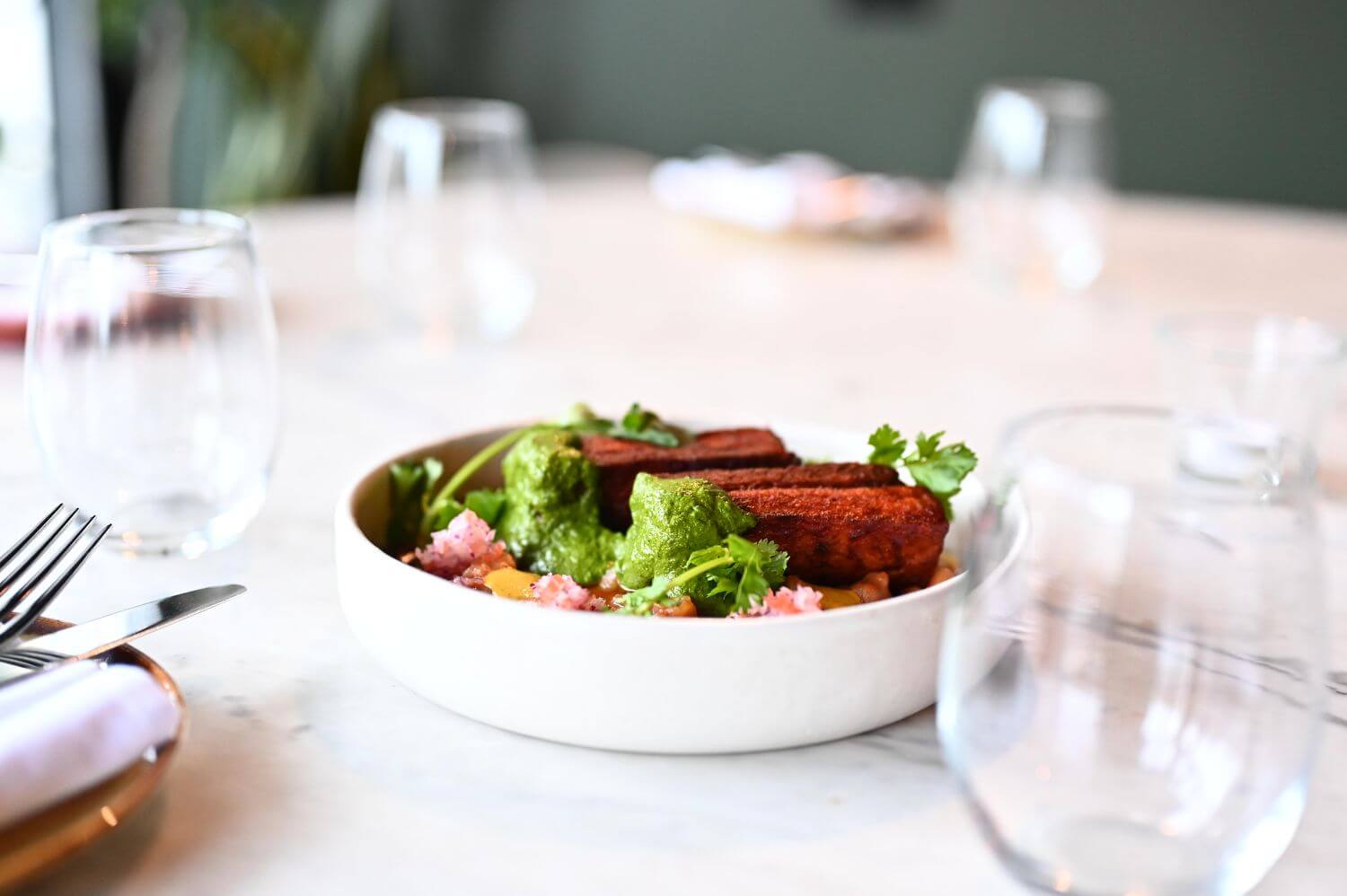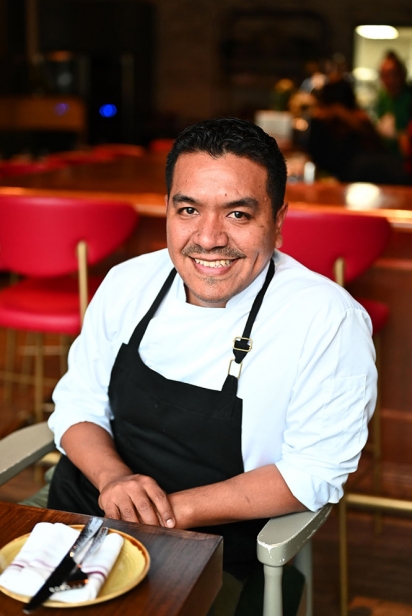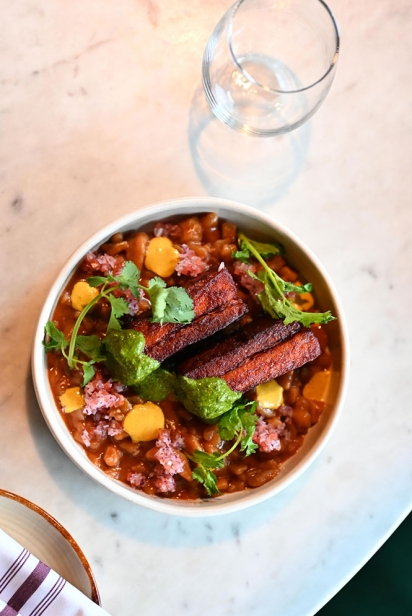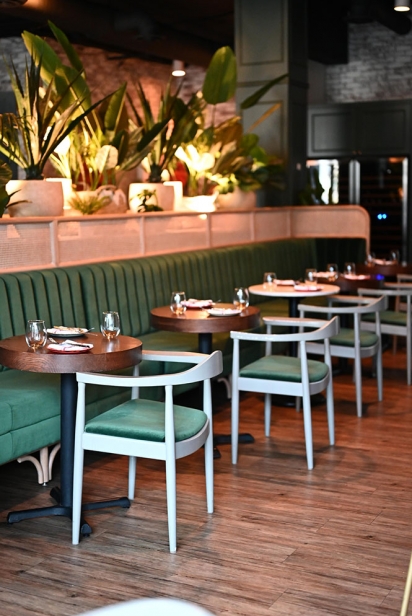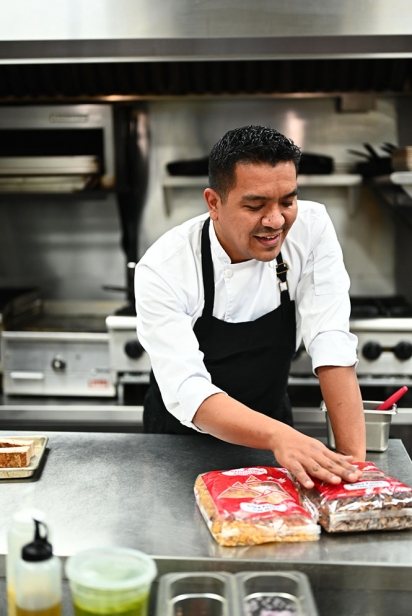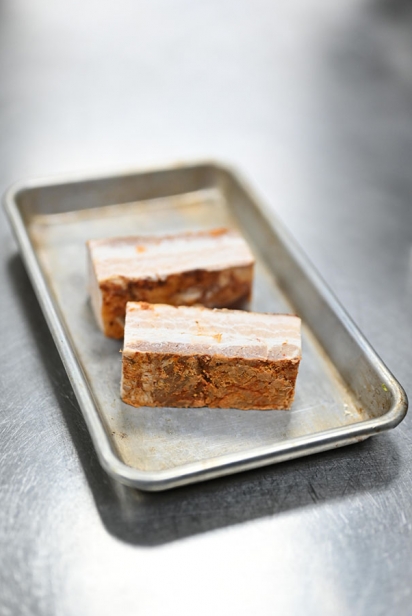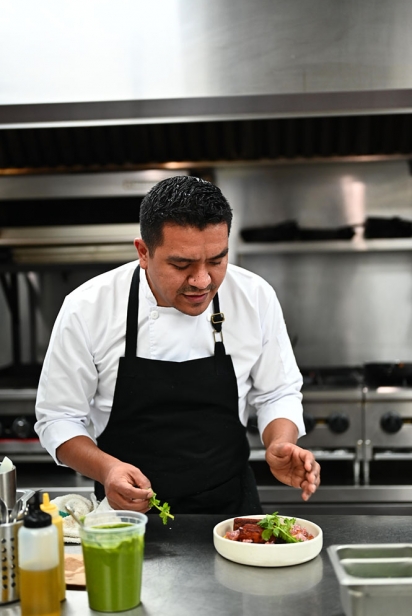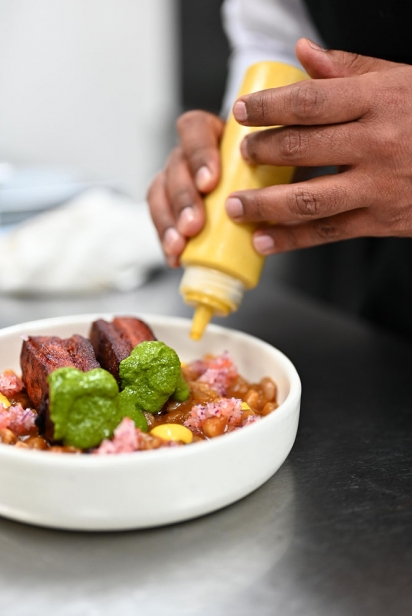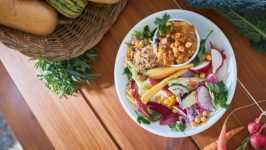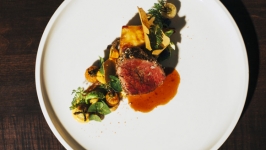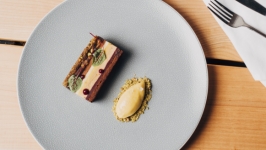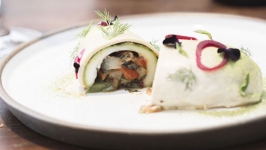'Is This My Restaurant?'
Lizardo Becerra says every dish on the menu at his Peruvian restaurant in downtown Ottawa represents “an emotion” or a memory.
“All of our dishes are memories — I remember going to the market with my dad and eating ceviche, so that is very personal and very beautiful,” he says.
His pork belly carapulcra is the dish he chose when edible Ottawa asked him to make something that represents him culinarily. It’s his best-selling dish and it keeps the customers coming back.
“Every single birthday, my mom would make carapulcra or another dish from where she was born in Lima — it was a district renowned for its creole food,” Becerra says. “My mom made carapulcra with chicken, but I realized Canadians love pork belly, so I make it with that. It's a dish that means a lot and there's a lot to say about it. It's very beautiful, very specific, very unique.”
The dish is made with sundried potatoes, which he buys in bags straight from Peru and rehydrates at the restaurant. They’re smoked naturally, he says, and sundried on the roofs of houses in the Andes. When the packaged potatoes arrive in Canada, they’re “super dry and hard,” so the chefs soak them overnight and then stews them in stock or demi-glace. Becerra says the stewing changes the molecules in the potatoes, making them creamy, and while not everyone knows what they’re eating, they know it tastes good.
Becerra uses a lot of potatoes in his dishes at Raphaël — after all, Peru is the birthplace of the potato. It was cultivated by the Incas more than 1,800 years ago and then taken to Europe by the Spanish, who colonized South America. Today, Becerra says there are 3,000 different varieties of potato in Peru.
“This dish means a lot to me because I ate it so many times when I was a kid and it’s a sign of celebrations or parties.”
After stewing the potatoes, Becerra flash-fries the pork belly, which has been braising for several hours, then brushes it with spices and finishes it in the oven so it crisps up.
“It’s a simple dish, a very colourful dish,” he says. “And there’s a lot of garnish going on.”
The garnish includes a healthy portion of his chimichurri sauce; along with a small salad known as salsa criolla, traditionally made with red onions, cilantro, ají Amarillo peppers, lime and tomatoes; and several dollops of ají de la casa, a spicy sauce made from ají Amarillo, a Peruvian yellow pepper. Becerra uses herbs such as mint, parsley and, in this case, cilantro for garnish instead of microgreens, because they’re more authentic. He’ll use microgreens for tiny canapés at events, but using the actual herbs in dishes makes more sense in his kitchen.
From international business to the kitchen
Becerra started his post-secondary education in international business. While he was doing well, he realized it wasn’t his first love and jumped at the opportunity to study cooking when he was 18.
“Universidad San Ignacio de Loyola was comparable to the Cordon Bleu,” he says. “At first, I wanted to just do pastry, but when I was in line to register, I realized that the program for culinary also included pastry, so I took that one because it was more complete. It took me two years to finish my degree. I loved it. The first day I came into my class and I got a big professional knife — it was the same as the first day when my son Raphaël was born. I instinctively knew how to carry him, I knew how to bathe him.”
He quickly realized he was happy cooking and was also good at it. His first job was at Katana, a small Japanese-Peruvian restaurant and then he had a couple of other jobs where he soaked up the learning like a piece of spongy focaccia. Then, he was approached by his former classmate Hibbett Antiporta, who asked him to join her, Virgilio Martinez and Pia Leon, the chefs at Central restaurant in Lima, which was named the best restaurant in the world in 2023 and known for its use of 180 different ingredients.
After a year at the Central, Becerra headed to Italy to study traditional Italian techniques for two months before joining the staff at then-two-Michelin-star Villa Crespi in Northern Italy and later the one-starred Guido de Costiglioli in Cuneo before returning to Lima for a short time. After eight months in Italy, having perfected his Italian techniques and the language, he returned to Lima and soon received a call from his alma mater, which had been tasked with finding private chefs for Peruvian ambassadors around the world.
“It was a great opportunity,” he says. “You don't have to worry about anything. [The embassy] does all the paperwork, the visa and everything, so it's an easy way to open up to the world. It was a beautiful experience — I was there for four years. We had three visiting presidents over that time. There were a lot of parties. It’s a big residence.”
By the end of his four years, he had become a permanent resident and left to work at the Andaz hotel with chef Stephen La Salle.
“Stephen was a great support,” Becerra says. “He was an influence who turned me into the chef I am right now.”
Raphaël restaurant and chicken to go
After the pandemic shut down Andaz, Becerra knew he had to do something else and he started working on the concept for Raphaël. He launched it as a takeout restaurant from a ghost kitchen at City Centre and then moved into a Clarence Street location as a popup. Though the ByWard Market location was busier in the summer, the Elgin Street location is busier overall.
“Clarence Street was a great success,” he says. “It was always meant to be a popup because we had a sublet from the former Clocktower, and then, because of that connection, we moved into this location,” he says, adding that he plans to stay on Elgin Street for the long haul.
And now, Ottawans can eat at a more family-friendly restaurant selling rotisserie chicken. It’s a concept he hopes to franchise eventually. When edible Ottawa visited Raphaël late in 2023, he had just taken possession of a professional rotisserie oven and was experimenting with it.
In early December, he started offering takeout rotisserie chicken under the brand Lima Peruvian Rotisserie. Whole, half and quarter chickens are available, along with “Lima” fries, yuca fries, garden salad, Peruvian-style chicken fried rice, aguadito (Peruvian soup) and a couple of authentic desserts.
“I think it’s a niche,” Becerra says. “People have been asking for polla a la brasa, so that’s what we’re doing.”
Lima Peruvian Rotisserie’s offerings are takeout-only from Raphaël until the concept moves to a bricks-and-mortar location. His capacity at the moment is 20 chickens per hour.
“The new location will be super-casual, sit-down,” he says. “It’ll be more colourful. It’s not fine dining; it’s fun dining.”
Inspirations and influences
When he decides to put together a dish, Becerra says he starts with a memory as a base.
“Then sometimes we tweak them, or use a different protein or sauce,” he says. “They’re all Peruvian dishes that we want to showcase. Peru is lucky because it has three geographic areas that are so different — the mountains, the Amazonas [jungle] and the coast.”
And, his democratic kitchen is a beehive of creativity and inspiration. Take Ronal Perez, with whom Becerra worked in Lima at the Bank and Commerce Club, and who is now the chef de partie on the hot side of the kitchen.
“That restaurant was where the president and the ministers would get together for dinners,” he says. “And that’s where I met Ronal. He had worked with Ivan Kisic, one of the top chefs in Peru, who was killed in the Andes doing potato research. He’s one of Lima's most renowned chefs, and Ronal learned so much from him. Ronal has worked in kitchens since he was 16, and he’s taught me many things.”
His chef de partie on the cold side of the kitchen is Noelia Cardenas. She, too, is part of the Central alumni group. She also worked at Fiesta, listed among the 15 best restaurants in South America.
And Hibbett Antiporta, who recruited him to Central back in the day, is his chef de cuisine.
One could ask how Becerra has been able to bring so many former colleagues from Lima. First, he says, it’s because he has a good lawyer who helps him with the piles of paperwork involved in sponsorship and also because Peru and Canada have treaties that help streamline immigration for skilled Peruvian chefs.
“I’m more than happy, shocked, and emotional because all the people I worked with before are coming and working with me again,” he says. “It’s very beautiful.”
Becerra’s life partner, Marie Dumont, is a part owner of Raphaël and runs the front of house. She was a staff member at the City Centre along with Becerra’s sister and they became a couple in 2020. And the restaurant remains a family affair, he says. The mother of his four-year-old son, the latter of whom is the restaurant’s namesake, is a fan of the restaurant and mother and son visit often.
“Raphaël will ask me, ‘Is this my restaurant?’ and I tell him, ‘Not yet,” Becerra says.
He says he may open for lunch someday, but for now, he’s aiming at making his dinner service even better and helping diners feel as though they’ve come to a new place when they walk through the doors of Raphaël.
Raphaël Peruvian Cuisine
200 Elgin St., Ottawa | raphaelperuviancuisine.ca
819.441.7090 | @raphaelperuviancuisine


